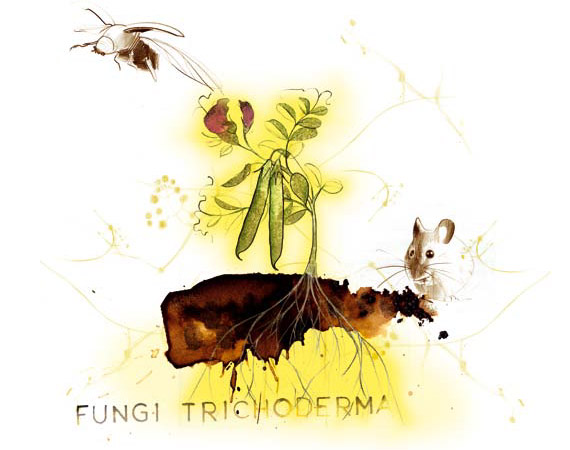Plant associated micro organisms
Author: Release Time:2020.11.24 Number Of Visitors:1697
Some of these micro-organisms have no effect on the plants and others are potential pathogens. However, many of these rhizosphere-dwellers actually serve to protect crops against other harmful pathogens and can even promote plant growth in a number of ways.
The specific characteristics of the rhizosphere vary from one plant species to another, which favours the development of different types of micro-organism. Bacteria of the genus Rhizobium, for example, only develop in the roots of legumes. The beneficial properties of these micro-organisms for plants can be harnessed to improve crops. Fertilizers and additives have been developed that encourage the plants’ defences, improve processes such as rooting and flowering and supply certain nutrients or help them to be assimilated. The micro-organisms in the rhizosphere that produce these beneficial effects are described in the rest of this article.
FUNGI Genus: Trichoderma
Fungi of the genus Trichoderma live in soils that are rich in organic plant matter. They can also establish symbiotic relationships with the roots of the plants growing in these soils. Numerous studies have shown the beneficial effects of Trichoderma, including:
Helping the plant to defend itself. Unlike animals, plants do not have the ability to produce antibodies to protect themselves against pathogens entering their organisms. However, they do produce other kinds of molecules, especially proteins and phytoalexins (substances with fungicidal and bactericidal properties) which help fight the effects of the pathogen. The plant starts to produce these substances when it detects that it is under attack from an insect or when it suffers damage from rodents or other herbivorous animals, for example.
The Trichoderma fungi secrete a series of substances that cause the plant to produce these defence proteins and phytoalexins even when they are not under attack by a parasite. Many phytopathogenic fungi produce enzymes that break down the cell walls of the plant they are infecting. As these cells decompose, this acts as a signal alerting the plant to the fact that it is under attack. The Trichoderma fungi produce enzymes, particularly cellulases, which break down organic matter (dead roots, remains of other plants, etc). The products of this enzymatic decomposition are very similar to those generated in a pathogen attack and they therefore replicate the signal, inducing the production of resistant substances.
MYCOPARASITISM
Mycoparasitism is the ability of these fungi to grow and act as parasites on other fungi which may be plant pathogens. For example, some species of Trichoderma can be useful for fighting and preventing Rhizoctonia solani, a fungus that causes damping off and root rot. Because of this, Trichoderma are also sprayed on leaves to fight fungal diseases such as oidium and mildew. In addition, this mycoparasitism stimulates the plant’s defences, since the substances produced in the breakdown of the pathogenic fungus are very similar to those that serve as a signal to alert the plant. For example, chitosan, a component of the cell wall of the fungi that is not found in plants, triggers the production of a series of defensive substances.
They also promote the growth of the host plant more generally by improving the assimilation of certain nutrients.
MYCORRHIZAE
Mycorrhizae are fungi that establish a symbiotic relationship with the roots of the plants in order to develop. Some edible fungi, including the extremely rare and valuable truffle, are mycorrhizae fungi that establish symbiotic relationships with the roots of different species, primarily hazel and oak. Depending on the way in which they colonize the root system, they can be classified as endomycorrhizae and ectomycorrhizae. In ectomycorrhizae, the mycelium only grows externally, surrounding the surface of the root or at most penetrating between the cells in the surface layers.
As secondary roots grow from these colonized roots, they are also enveloped in the mycelium of the fungus. The plant can use the mycelium, which extends beyond its root system, to gather nutrients lying beyond its reach.
In the case of the endomycorrhizae, the process of colonization involves penetrating the cells. There are various types of endomycorrhizae, but the most important ones from an agricultural point of view are the vesiculararbuscular mycorrhizae or VA M. They include Glomus, Gigaspora, Acaulospora and Sclerocystis.
In the symbiotic relationship, the plant provides the fungus with sugar from photoassimilates and the mycorrhizae provides nutrients which the plant either cannot assimilate itself or can only produce in very small quantities.
Phytoremediation refers to the use of plants to eliminate toxic substances from the soil. Mycorrhizae fungi have been used to promote these plants’ capacity to absorb certain toxic elements or aid its distribution through the plant. It has been shown, for example, that the symbiosis of the Glomus mycorrhizae with the roots of the hemp plant helps in the translocation of toxic metals from the roots to the shoots.

Many phytopathogenic fungi produce enzymes that break down the cell walls of a plant that has been damaged by rodents, herbivorous animals or parasites. As these cells decompose, this acts as a signal alerting the plant to the fact that it is under attack. The Trichoderma fungi produce enzymes which break down organic matter. The products of this enzymatic decomposition are very similar to those generated in a pathogen attack. They replicate the signal and the production of a resistant substance.
CYANOBACTERIA
Cyanobacteria are photosynthetic bacteria. Some enter into symbiosis with plants; these include the bacteria Anabaena azollae which establishes a symbiotic relationship with the aquatic fern Azolla. These bacteria are atmosphericnitrogen fixers and provide various stimulants such as phytohormones. The nitrogen fixed by the fern-bacteria symbiosis has been widely used for fertilizing paddy fields, with the ferns grown prior to planting the rice. As the rice grows and the ferns die, the accumulated nitrogen is released and can then be used by the rice plants.
RHIZOBACTERIA
Rhizobacteria are bacteria that colonize and develop in or near to the plant root system. They are the most abundant of all the micro-organisms in the rhizosphere. The positive effect of these bacteria on the colonized plants was first observed in ancient times, when growers discovered that crops could be improved by planting them in a field that had previously been used for growing legumes. More recently, various studies have demonstrated various properties of some rhizobacteria. These beneficial bacteria are known as plant growth-promoting rhizobacteria (PGPR).
Nitrogen-fixing
The rhizobium-Leguminosae symbiosis was probably the first to be used by humans to improve crop yields. Growers also noticed that the fastest-growing and best-producing plants had protuberances on their roots, called nodules, which were much less common on other plants.
In 1888, the German researchers Hellriegel and Wilfarth showed that it was in these nodules that nitrogen accumulated. The Dutch scientist Beijirink subsequently isolated the bacteria in the nodules. They belong to the genus Rhizobium, which, through the action of nitrogenase enzymes, convert atmospheric nitrogen – which cannot be used directly by the plant – into ammonium that plants can assimilate easily. This transformation occurs inside the nodules, which contain a characteristic dense pinkish liquid. The relationship between Rhizobium and Leguminosae is said to be endophytic because the bacteria develop inside the host plant. Other endophytic bacteria that are also nitrogen fixers include Azetobactor diazotrophicus, which develops inside the sugar cane plant and spreads throughout its vascular system.
The actinomycete Frankia also forms nodules with nitrogen-fixing capacities in some trees and bushes of the genus Casuarina.
There are other bacteria that fix atmospheric nitrogen, colonizing the roots of non-leguminous plants. Unlike Rhizobium, they do not develop inside the tissues of the host but in the rhizosphere. This is true of bacteria in the genus Azospirillum, for example.
Other nitrogen-fixing bacteria do not develop inside plants or in the rhizosphere and are therefore not considered to be rhizobacteria. These include bacteria in the genus Azotobacter which feed off decomposing organic matter in the soil.
From CANNA Research








